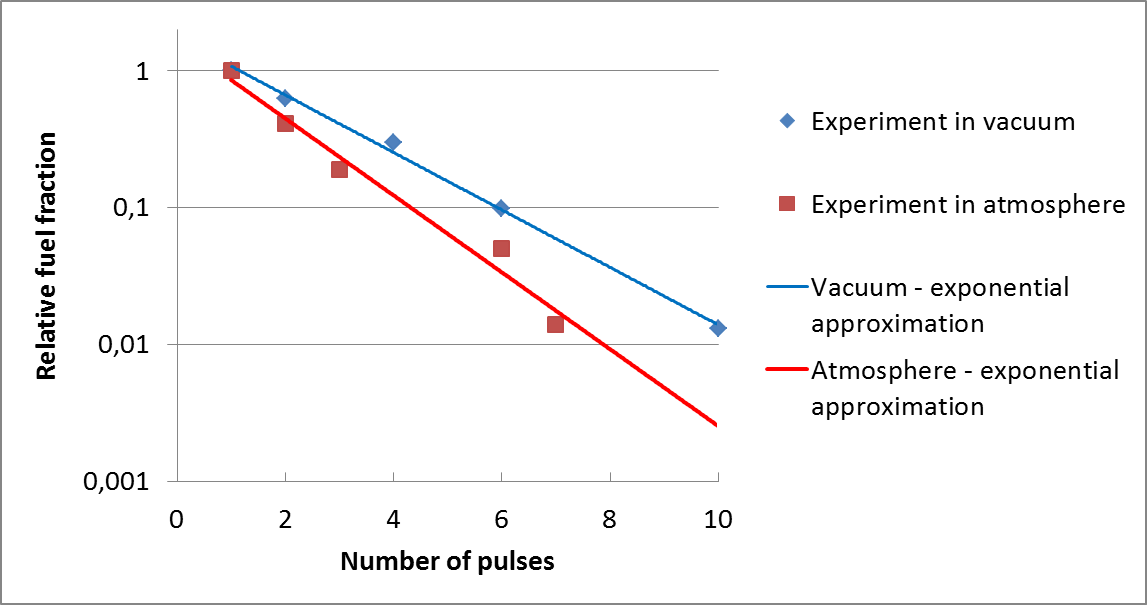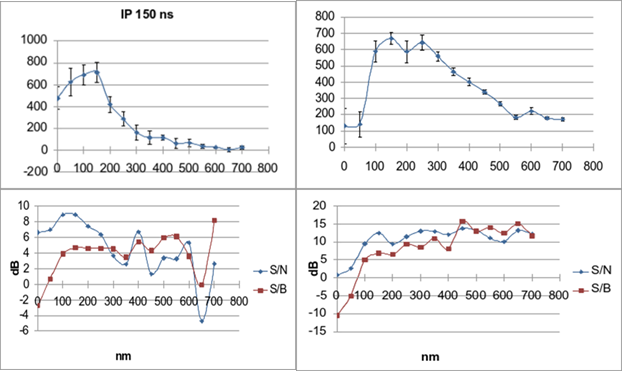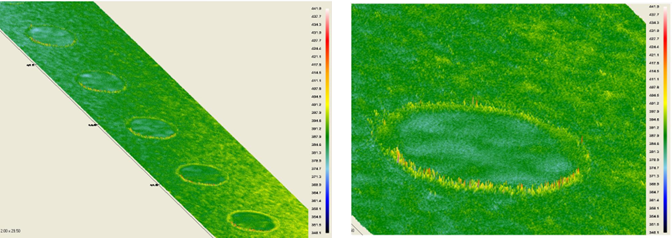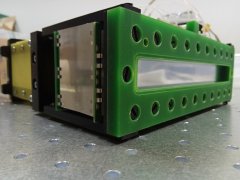In 2019, research conducted at IFPILM under the Eurofusion WPPFC project: Preparation of efficient PFC operation for ITER and DEMO can be divided into two thematic groups: (1) works related to the study of hydrogen isotope retention on samples simulating codeposit in fusion reactors and (2) experiments aimed at detailed study of the dynamics of the plasma generated by a two-pulse laser from tungsten samples (simulating the divider material of ITER reactor), as well as the surface effects of these interactions.
In experiments (1) whose main purpose was to characterize fuel retention and its removal, samples made on tungsten and molybdenum substrates, covered with tungsten and tantalum and aluminum layers, were tested during subsequent laser pulses. The layers had a thickness of 2 to 5 μm and contained 5 to 10% deuterium (in terms of the number of atoms). A two-pulse variant of the LIBS method was used, and the measurements were performed in a vacuum chamber at a pressure of 10^-5 mbar and in an atmosphere of gases at a pressure from single mbar to atmospheric. As a source of radiation, a two-pulse LOTIS Tii laser was used - allowing the use of pulses from several dozen to about 200 mJ with inter-pulse separation from single nanoseconds to several dozen microseconds with nanosecond resolution. The research used 100 mJ pulse energy, due to the sufficient signal level obtained at this energy and the limited material damage that increases with increasing energy.
The measurements were carried out using a MECHELLE 5000 spectrometer equipped with an ICCD ISTAR camera, triggered by the q-switch cell of the first laser path. As a point of reference for determining the time dependence, a photo-peak signal was used that was detected in the case of vacuum measurements using a Faraday can placed 60 cm from the laser spot, from which the ion signal was recorded with a 4-channel digital oscilloscope. Other signals under observation corresponded to the triggering of cells q-switch of the laser and the signal monitoring the gate opening of the ICCD camera.
At the initial stage of the experiment, optimal temporal parameters were selected, the approximate values of which had been known on the basis of tests carried out in previous years, but which required accurate justification due to differences between individual samples and the drift of instrumentation parameters resulting from the operational aging of the elements. In the case of the measurements performed in a vacuum, the optimal interval between pulses was estimated at 150 ns, and the acquisition delay, with a gate opening time of 100 ns, at 200 ns, after the second laser pulse. With such settings, a linear spectrum was recorded, while the background component (mainly resulting from bremsstrahlung radiation dominating in the initial phase of plasma expansion) was absent in the recorded signal. For measurements with increasing pressure, the optimal values of both the inter-pulse separation, as well as the delay and acquisition time were higher, and ranging from 20 mbar to atmospheric pressure were 1, 1.5 and 0.5 µs, respectively.
Measurements, apart from the correct identification of elements present in the samples, showed the expected dependence of the number of fuel particles on the number of laser pulses. Sample results for a tungsten sample coated with a 5 µm tungsten aluminum layer containing 5 atomic percent deuterium.

Fig. 1. Evolution of deuterium content depending on the number of double laser pulses on a linear (left) and logarithmic (right) scale.
The presented measurements confirm the logarithmic decrease in the concentration of fuel molecules depending on the number of delivered pulses, which can easily be approximated by the appropriate function (shown on the graph). This indicates the thermal nature of the removal of the gaseous component from the areas of the layer located below the impact surface.
Interesting information is also provided by the comparison of the rate of fuel removal in vacuum and in atmospheric conditions presented on a logarithmic scale in Figure 2.

Fig. 2. Comparison of deuterium content at subsequent laser pulses in a vacuum and in air at atmospheric pressure
Experiments have shown that under atmospheric conditions, fuel removal is slightly faster, which is related to the longer life time of the plasma, and thus the extension of thermal interactions with the material surface. After about 7 pulses at atmospheric pressure and 10 pulses in a vacuum, the signal amplitude corresponding to the deuterium line reaches the background level, which indicates complete removal of this isotope.
Tests (2) aimed at examining tungsten plasma and estimating the surface effects of two-pulse interactions were carried out under vacuum conditions using laser beam parameters analogous to those used for the fuel removal tests described in the previous section. The experiments consisted of recording subsequent spectra with a short gate opening time (50 ns), with a sliding gate opening delay with a 50 ns step in the range from 0 to 500 ns. Subsequent measurement series were performed for a changing inter-pulse delay of 0 to 650 ns with a variable step. Then, various tungsten lines were considered to study the evolution of their intensity, and signal-to-noise and signal-to-background ratios (S/N, S/B). Sample graphs illustrating the behavior of the WII 364.1 and WI 429.5 nm lines for an inter-pulse delay of 150 ns are shown in Figure 3.

Fig. 3. Evolution of the signal strength corresponding to the tungsten lines WII 364.1 and WI 429.5 nm for 150 ns inter-pulse separation (upper row) and the change of signal to noise (S/N) and signal to background (S/B) ratios.
The differences in evolution of atomic and ionic lines captured in the drawing illustrate well the behavior of the plasma, in which ionized components dominate at the early stage of exploding, as a result of which it is more difficult to isolate them from the background at this stage. Thanks to this, this observation allows optimization of the selection of the delay time for measurements of various plasma components depending on their degree of ionization. Research has also enabled the optimization of the inter-pulse interval for tungsten based on a comparison of the subsequent values of the signal-to-noise ratio and background. An example analysis for the previously mentioned is presented in the table below.

Data analysis showed that compared to the single-pulse method, the two-pulse method allows to obtain better signal parameters for tungsten, however, the improvement is not as great as in the case of the carbon tested a year ago. This is due to the nature of the material, which is very difficult to sputter and additionally has a complex spectrum containing a lot of lines. The positive aspect is that the tungsten difficulties do not interfere with the measurement of isotopes of hydrogen, carbon and other elements present in the tested samples.
In studies on the surface effects of laser interaction using an NANOVEA optical profilometer, it was found that they fundamentally differ in the case of layers and the substrate. In the case of layers, the ablation coefficient for pulses of 50 - 100 mJ is 0.5 to 1 μm, and for pulses with higher energies there is often defoliation, i.e. local loss of the entire layer. When interacting with a tungsten substrate, the ablation coefficient for 100 mJ pulses did not exceed 100 nm per pulse under experimental conditions. The impacts did not lead to the formation of a Gaussian crater, but flat, with a roughness not differing from that of the surrounding area. The crater's edge was modified to the greatest extent, where the area of sharp waving material (so-called burr) was created, which is characteristic for nanosecond interactions and increases with the number of impulses deposited in one place due to the accumulation of small effects related to thermal expansion. The depth of the resulting craters was slightly dependent on the inter-pulse spacing.
Sample crater maps are shown in Figure 4.

Fig. 4. Row of craters obtained for different inter-pulse delays and an enlarged image of a single crater
The results obtained were regularly reported and compared with the results of groups working on similar issues under the Eurofusion WPPFC project: Preparation of efficient PFC operation for ITER and DEMO, and finalized at the summarizing Plasma Wall Interaction Meeting, which took place in Bratislava in November 2019. Results obtained by individual groups were consistent and served as a starting point for research on the further development of the use of LIBS for thermonuclear fusion, which were outlined at the meeting at the turn of January and February 2020. These plans are presented in "current plans".










